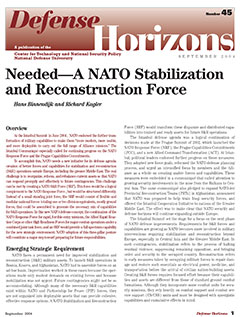DOWNLOAD PDF
 Overview
Overview
At the Istanbul Summit in June 2004 , NATO endorsed the further transformation
of military capabilities to make them “more modern, more usable,
and more deployable to carry out the full range of Alliance missions.” The
Istanbul Communiqué especially called for continuing progress on the NATO
Response Force and the Prague Capabilities Commitments.
To accomplish this, NATO needs a new initiative for its defense agenda:
creation of better forces and capabilities for stabilization and reconstruction
(S&R) operations outside Europe, including the greater Middle East. The real
challenge is to reorganize, refocus, and rebalance current assets so that NATO
can respond promptly and effectively to future contingencies. This challenge
can be met by creating a NATO S&R Force (SRF). This force would be a logical
complement to the NATO Response Force , but would be structured differently.
Instead of a small standing joint force, the SRF would consist of flexible and
modular national forces totaling one or two division-equivalents, mostly ground
forces, that could be assembled to generate the necessary mix of capabilities
for S&R operations. In this new NATO defense concept, the combination of the
NATO Response Force for rapid, forcible-entry missions, the Allied Rapid Reaction
Corps or other High Readiness Forces for major combat operations under a
combined joint task force, and an SRF would provide a full-spectrum capability
for the new strategic environment. NATO adoption of this three-pillar posture
will constitute a major step toward preparing for future responsibilities.
READ MORE >>